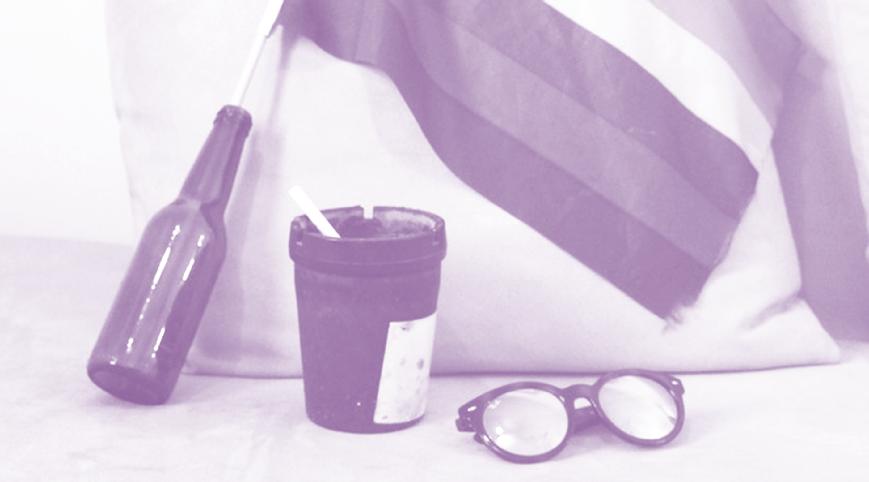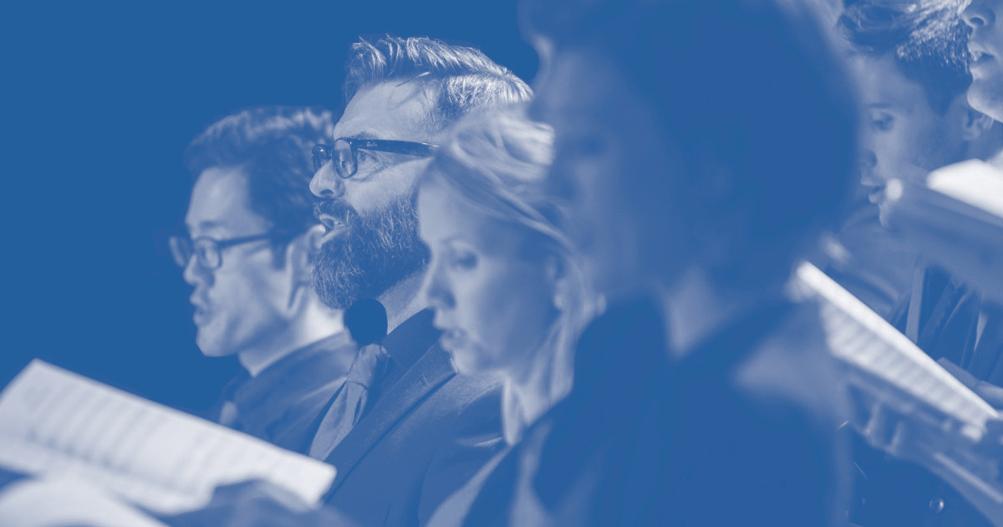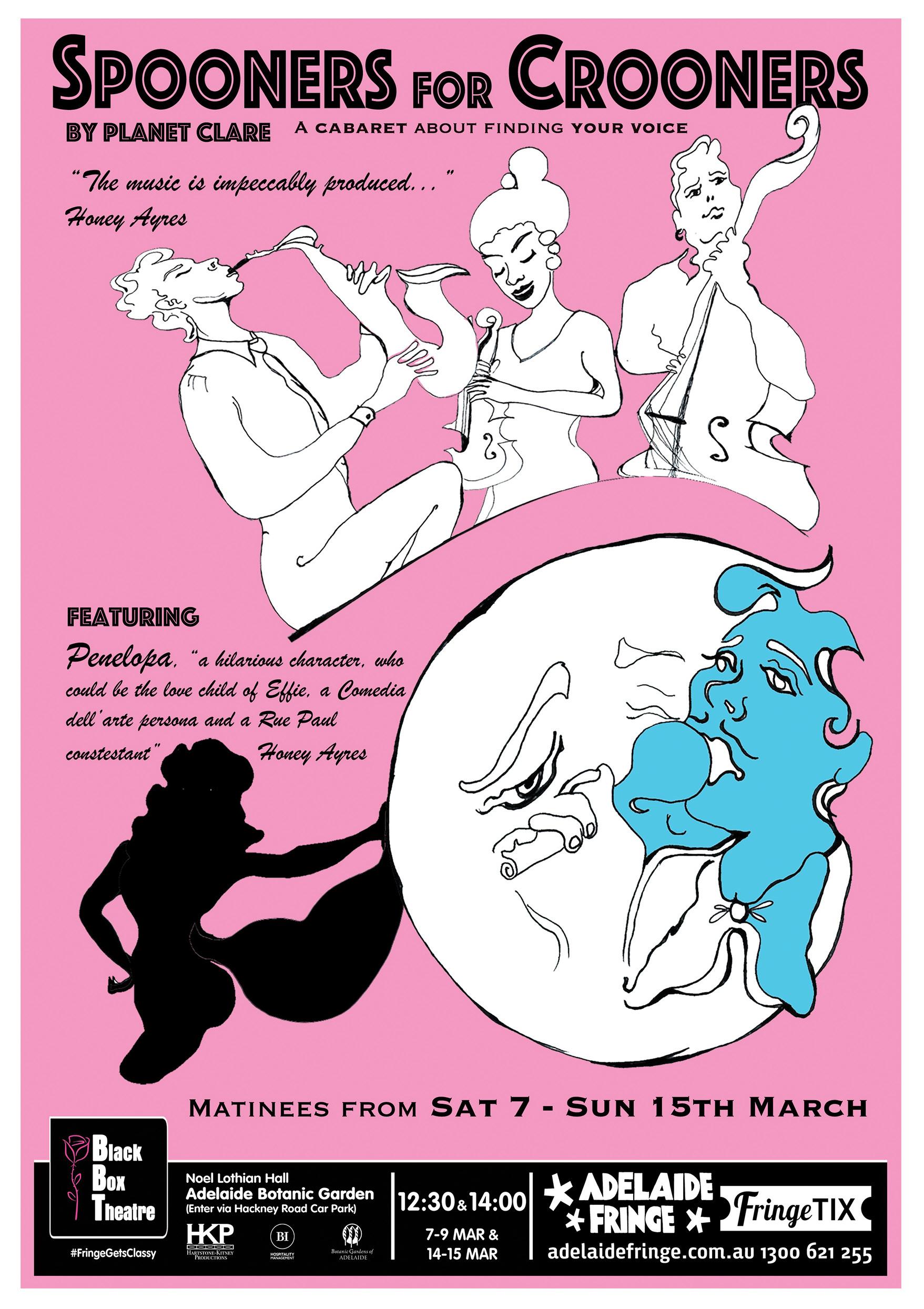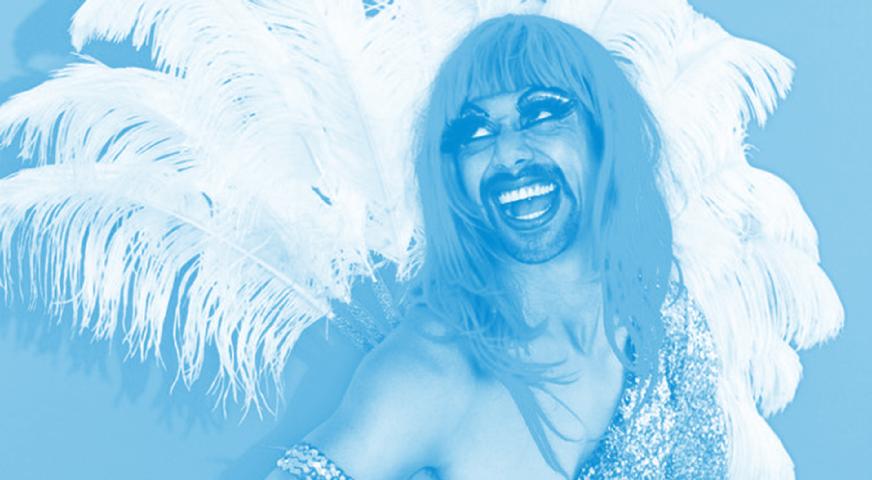
18 minute read
Frankenstein
Theatre Reviews
Credit: Joyce Nicholls
Advertisement
Frankenstein: How to Make a Monster HHHHH
VENUE:
TIME:
TICKETS:
RCC 6:30pm, 15 Feb – 15 Mar $25 – $35
There might be a handful of red flags if you spot this show in the program. The 80 minute runtime, for one; young folks doing beatbox ing, for another. But check your preconceptions at the door. This is a remarkable, once-in-a-Fringe kind of production.
The talk of the town at last year’s Edinburgh Fringe, Frankenstein: How to Make a Monster is a gig-the atre retelling of Mary Shelley’s iconic horror novel. The kicker is that it’s performed by members of the BAC Beatbox Academy – a London-based collective that works with kids from all walks of life and trains them up in vocal wizardry. That is to say, singing, rapping, spoken word, and – of course – beatboxing, that beguiling and sometimes uncanny trick of imitating drum sounds.
All of these vocal skills are utilised – and only vocals, it’s important to stress, no matter what sounds you think you’re hearing – to unpack, dice up, reinterpret and redefine the Frankenstein myth. It’s given a shake-up for the modern age, exploring how society creates monsters and the pain of systemic othering. What makes the show so compelling, beyond the incompre hensible talent of the six on stage, is the genuine energy and passion that beams out of this young, diverse cast.
The a cappella virtuosity, original songs and captivating lighting would be enough to make this a winner. Add in their commitment to community outreach (for Adelaide, they’ve worked with Carclew to run beatbox sessions for local youth) and you have a show that doesn’t compromise its social message for the sake of entertainment. ✏︎ George Sully fest-mag.com
Kafka’s Ape HHHH H
VENUE:
TIME:
TICKETS:
Holden Street Theatres times vary, 5 Feb – 15 Mar, not 2, 9 Mar $20 – $25
A hunched ex-ape gives his report of his transformation to a man. Ag ile yet rotund, Tony Bonani Miyambo is captivating as Red Peter. With a minimal set, he transforms from a sauntering ape – out of place with his cane and briefcase – into a socially-acceptable ‘ex-ape’. Red Peter isn’t a man, but he is moving in man’s space.
With few props and tight lighting, Miyambo acts out his story of being hunted, shipped and trained with claustrophobic emotion. Strained by language and frustration, Red Peter describes his gunshot wound, his cell, his trainer.
What is so utterly devastating about Red Peter’s story is that it is one of so many people of Africa. The dehumanisation of Red Peter is thinly veiled and is not a far cry from the social dehumanisation seen in Apartheid-era South Africa.

Watching Red Peter recall un learning his ape-ness and culture is heartbreaking – to change all but his fur to fit into a world which doesn’t want him. ✏︎ Laura Desmond
The Doctor HHHH H
VENUE:
TIME
Dunstan Playhouse [Adelaide Festival] run ended
Do you let her die in her ignorant delirium? Or do you snatch her out, cause panic, and relieve her of her mortal sins?
Juliet Stevenson is Ruth Wolff – the professor in charge of making that very decision. Stevenson is sure, fierce and ethical in her posi tion – but what follows is an unrav elling tapestry of complexities.
The first act follows the facility’s team discussing how to cope with the public backlash and divisions between the small team are clear. Things are not as they seem, however – the casting is such that you cannot know the sex nor race of a character by their actor.
As female actors are ‘outed’ as male doctors, the issue of bias is pushed to the forefront. Was that character being treated differently for being a man? A woman?
The second act is a powerfully uncomfortable conversation of systemic issues and privilege. Wolff is attacked from all angles – race, bias, power, religion, choice – and cracks begin to show. As the multitude of relevant issues rise against Wolff, perspective shifts. Right and wrong are blurred by the lens through which you choose to view Wolff’s choice.
Bodily autonomy, religious freedom, racial labels, oppres sion, privilege – these issues are increasingly relevant in today’s world and The Doctor poses bold questions. ✏︎ Laura Desmond




COMA HHHH H
VENUE:
TIME:
TICKETS:
The Garden of Unearthly Delights times vary, 14 Feb – 15 Mar $25
Darkfield have developed a number of immersive theatrical experi ences in shipping containers, and COMA is the most enjoyable so far. Where Seance tried to trick audiences and Flight relied on confusion, COMA works with the power of suggestion. As a result, it’s the most effective of the trio. The shipping container is lined with rows of bunks, each with a set of headphones on the pillow. This ‘seating’ format intentionally isolates every member of the audi ence, dispatching each individual to a solipsistic void once the lights go down. Alone and entirely free of distractions, we have no choice but to invest in the performance.
Binaural technology allows for an aural experience much richer than stereo, and sounds seem to come from every direction. As some senses are stimulated and others deprived, those things that the audience can perceive are mag nified. A disembodied voice invites

us to relax. Next, it asks us to trust it. This stranger simultaneously soothes and questions the nature of this new reality, lulling us into a dreamlike state. And because we’re asked, rather than forced, to embark on this journey, it’s easy to follow the hypnotic voice to another realm.
Time stops in a vacuum, and stretches out disconcertingly when you’re completely dark and alone. Though this performance lasts just twenty minutes, it feels like it’s far longer and COMA’s ability to take audiences on a journey without the use of their eyes is quite an achievement. ✏︎ Alexis Buxton-Collins
Craigslist Allstars HHH HH
VENUE:
TIME::
At the age of 24, Samira Elagoz put a simple ad on Craigslist. As a filmmaker, she was seeking males who would accept her and her camera into their homes to record their first meeting. Elagoz filmed across three cities over a number of years and her resulting work, Craigslist Allstars, is a film which blurs lines between documentary and softcore por nography. Interestingly, although not mentioned at all in the original advertisment, almost every partic ipant uses his time to discuss sex. Fetishes such as sadism, exhibi tionism and shibari (Japanese rope binding) are discussed and played out in front of Elagoz.
A number of the men have sexual relations with Elagoz, which is shown graphically. This is an important element to the work. The genuine interactions between people show how intimacy can be forged between two willing participants quickly. Regardless of any sexual act, Elagoz is sharing intimate moments with each of the men she meets on camera. Craigslist Allstars seems to add evidence to the stereotype of men never being able to think of any thing but sex, but it also showcases female sexuality and choice in an honest and sex-positive way. ✏︎ Laura Desmond
Cassie and the Lights HHH HH
VENUE:
TIME:
TICKETS:
RCC 6pm, 14 Feb – 15 Mar $20 – $26
Cassie is 17. Her two younger siblings are still in primary school. After leaving one night to buy them slushies, their mother fails to return home. It’s left to Cassie to try and pull together the remnants of a family.
From Patch of Blue Theatre comes this playful and inspiring story that idles between the realms of childish games and adult respon sibilities. Is Cassie capable of caring for her siblings? Would they be better off in foster care? How does the justice system fail children? The script is based on real-life events and interviews with children in care. This is brought to life by the unique and captivating perfor mances by Alex Brain (Cassie), Michaela Murphy (Tin) and Emily McGlynn (Kit). All three charac ters are well-imagined and have endearing, comedic, and distinct idiosyncrasies and mannerisms. Brain wavers a little in portraying the full complexities and anguish her character is facing. In general though, the cast is mesmerising. The biggest drawback is the plot’s failure to put enough at stake for the audience to become fully invested. The two possible out comes are almost equally weighted as both situations have their pros and cons. There’s a lack of tension because of this indifference.
However, the creative live music and projections really bring the piece together and the cast more than captures the vulnerability and strength of children placed into the foster care system. ✏︎ Edwina Sleigh
Queer House Rules! HHH HH
VENUE:
TIME:
RUMPUS run ended
Four housemates discover they have a surprise inspection, with only a few hours to prepare. Emily (Flinty McBain) hasn’t tidied up the shared areas like she promised she would. Her best-friend, Daisy (Lillian Cheyne), is exhausted from working back-to-back hospitality shifts. Loveable goof Brad (Aidan Moller) hasn’t done the shopping like he was supposed to. While Jamie (Jess Wong) is left to play the role of house mediator. In the rush to clean all the things, sim mering tensions rise to the fore. The performances in this four-hander are all very enjoyable but slightly unpolished. McBain and Cheyne offer grounded por trayals, but can be so soft-spoken that it’s a struggle to clearly discern their dialogue at times. Moller is more at ease on stage, but he isn’t given as much to work with. The clear standout is Wong, who brings Jamie to brilliant life through unique and unconventional acting choices.
Guy Henderson’s original script is warm, light, and grounded in its depiction of lesbian, bi, gender

non-conforming and straight folk. Peppered with contemporary references and vagina-based puns, it’s more sweet and amusing than sharp or incisive. Yet this is an entertaining show worth the price of admission. ✏︎ Justin Boden fest-mag.com
NO COUNTRY FOR OLD MEN + TROPICAL F*CK- STORM HHHHH
VENUE:
TIME:
RCC run ended
Joel and Ethan Coen’s taut, sparse cat-and-mouse thriller No Country for Old Men is, in some respects, an odd choice of film to get the live score treatment.
Pockets of dense dialogue dec orate an otherwise quiet, spacious story, as Javier Bardem’s chilling psychopath Anton Chigurh silently pursues Josh Brolin’s moody Llewelyn Moss across the deserts of 1980s Texas. While the film was rightly praised upon its 2007 release, many critics specifically lauded its lack of noticeable score. For Melbourne art-psych prog quartet Tropical Fuck Storm to be enlisted as live accompaniment by seasoned film/band matchmakers Hear My Eyes, the exercise is one of restraint. Judicious use of am bient guitar, bass and electronics, with even more sparing percussion, ensure the band enhances – rather than competes with – the film’s neo-Western aesthetic.
In fact, one criticism – if it can be called one – is that the sound pairings are so perfectly executed

you frequently forget the band is even there.
But Gareth Liddiard and his bandmates do not disappear into the background. Coiled like rattlesnakes beneath the screen, they react with exquisite timing to key climaxes, channelling the tense tempo inherent to the Coen brothers’ masterpiece.
They add renewed personality to hallmark scenes, often evoking Dave Porter’s atmospheric work on Breaking Bad and its arid New Mexico landscapes. At one point they even sample a gunshot sound, incorporating it into the music, ratcheting up the tension to heights that Carter Burwell’s original minimalist score could never reach. ✏ George Sully
VENUE:
TIME:
multiple venues [Adelaide Festival] run ended
David, King of Israel, perhaps one of history’s greatest poets, wrote his Psalms from the heart: to ex press the joy, grief and complexity of life. Many others have since found solace in these texts.
Over four nights, 12 individual performances by some of the best choirs in the world – The Tallis Scholars, The Netherlands Cham ber Choir, The Song Company and The Norwegian Soloists’ Choir – sing all 150 Psalms by 150 compos ers in four different locations; three religious, one secular. The compositions in 150 Psalms range from responsorial Gregorian and Taizé chants to the complex canon perpetuus of Monteverdi, Brahms and Bach. Some were com posed as early as the 10th century in Latin, German, French and Eng lish. Others come from the postWorld War era, such as Kodály’s Psalm 50 – an act of resistance against Soviet occupation.
The depth, purity and focus of each choir can be attributed to their skill, but also to the century’s old choral tradition. Delicate refrains balance with rich cre scendos and key voices. Such as the Netherland’s Chamber Choir soprano Mónica Monteiro’s solo of Huygen’s Psalm 35; Gilad Nezer’s bone-rattling bass in Becker’s Psalm 53, and the rhythmic, folklike joviality of Gretchaninov or Hammerschmidt. As with some of the most skilled choirs, the sound of these singers often seems to replicate that of one giant musical instrument. Yet no individual voice is lost, nor the original composer’s intent.
Each performance is grouped into a separate theme of scripture. These range from justice to trust, leadership to power, and to oppression. Keynote speakers introduce these themes – including Prof. Danielle Cellermajer, Order of Australia recipient, Tim Costel lo and Walkley award-winning journalist Kerry O’Brien. Each has an unabashed response to topics like income inequality, climate change and the refugee crisis. The Psalms’ capaciousness is exactly what makes them so perfect for such a plaintive task, challenging the automaticity by which we live our lives.
We may take a verse, unravel it and ask ourselves: What do these themes mean for us here and now in Australia? ✏ Emma Heidenreich
This review is based on the performances of Justice (The Song Company), Suffering (Netherlands Chamber Choir) and Celebration of Life (Netherlands Chamber Choir; The Tallis Scholars; The Norweigian Soloists’ Choir; The Song Company) which ran from 29 Feb–1 Mar

VENUE:
TIME:
Festival Theatre [Adelaide Festival] run ended
At the age of 35, Wolfgang Amadeus Mozart died. His seminal work Requiem in D Minor – a repose for dead souls – was, ironi cally, not finished.
Romeo Castellucci recre ates Requiem with heady symbolism – a funeral song for life as we know it. He seems to ask the questions: Why do human beings conduct omnicide? Does a God of love and mercy, hear our cry for forgiveness?
Using trickery with the lights and surrealism, Castellucci trans forms the space into a sepulchre of sorts – scenes of death are played out, from car accidents to genocide and, in each, the fragility of the human condition and the innocence of the young are central. There is so much to this piece, it is impossible to unpack in a short time. At some points, the space is overcrowded with meaning – there are scriptures rolling overhead, an Atlas of Extinctions on the back drop and several separate actions onstage. Requiem is technically and mu sically brilliant. In particular, treble Luca Shin and the Adelaide Sym phony Orchestra prove themselves a match for Castellucci’s ambitious feat. ✏︎ Emma Heidenreich
Buŋgul HHH HH
VENUE:
TIME::

Thebarton Theatre [Adelaide Festival] run ended
Despite Gurrumul Yunupiŋu’s in ternational and domestic success, his works – particularly those contained in posthumous album Djarimirri (Child of the Rainbow) – were not always well understood. Buŋgul is the generous antidote to this gap in comprehension around a great Australian musi cian. Yolŋgu dancers, Songmen, and artists from Gurrumul’s community in North East Arnhem Land offer insight into the timeless stories woven into his songs. Di rected by Senior Yolŋgu Don Wininba Ganambarr and Nigel Jamieson, the show is structured around the tracks of Djarimirri and performed by the Yolŋgu artists with Adelaide Festival Orchestra.
Recordings of Gurrumul’s transcendent voice soar over the powerful orchestral ensemble and each song swells to fill the The barton Theatre, but it is the Yolŋgu performers who hold the audi ence’s attention. This handful of men elegantly present elements of ceremony, including dancing, body painting, singing, and instrumen tation. There is an intensity that is rarely seen on stage – an emotional and intellectual commitment to every movement. It is impossible to look away.
While many of these actions may be unfamiliar to audience members not from a Yolŋgu background, the men embody each moment with such clear intention that meaning ripples out into the crowd.
The men and the orchestra per form with an enormous projection behind them, alternating between footage of North East Arnhem Land, film of the Yolŋgu artists performing on country, depictions of artworks created by community members, and live footage of what is happening on stage.
Individual elements of this projection are beautiful – the artworks and the on-country vision are particularly compelling. Yet the mesh of different visuals is not always balanced and the projection detracts from what is happening onstage by presenting a competing version of the same ceremonial performance.
The need for simplicity is underlined in the most powerful moments, occurring between and at the end of songs. For periods no longer than a minute or two, the orchestra ceases playing, the projection fades to black, and the Yolŋgu performers are given space to sing, dance, and make music alone. It is these moments that grab at something deep in the viewer and offer flashes of truth. They are extraordinary, but denied the space and time they deserve. ✏︎ Farrin Foster

Cabaret Reviews

Snap Crackle Pop HHHH H
VENUE:
TIME:
TICKETS:
RCC 9:30pm, 15 Mar $20
Adelaide University’s previous UniBar site is unrecognisable as Melbourne-based Poof Doof’s Snap Crackle Pop takeover the venue. Bass throbs through the floor as the piercing green and red lights flash through the crowd as Grove from Frankenstein: How To Make a Monster tears up the DJ decks. Towering queens Karen from Finance and Daisy Confused wander through the crowd for photos and shots, before taking to the stage for a lip sync show. Karen from Finance’s ‘9 to 5’ routine is uninspired, but brings up the energy of the room with an easy singalong.
Daisy Confused is striking as she strips and syncs to Shania Twain’s ‘Man! I Feel Like a Woman’, showing off her legs that seem to go for days. Dollar Bin Darlings pumping Disco with a capital D provides a great grounding for a genuinely fun dance party.
With all walks of life moving their bodies on the dancefloor, there is an electricity in the air – one of acceptance and love. This is what separates Snap Crackle Pop from a regular club night, and makes it one helluva party.
For those with the stamina, Poof Doof crackle on into the wee hours of the morning. ✏︎ Laura Desmond
Season of the Witch HHHH H
VENUE:
TIME:
Mary’s Poppin run ended
Wundes emerges in a black bodysuit and bright flower-like tulle. They belt out Judy Garland’s ‘Over the Rainbow’ and, it is clear, we are watching a powerhouse performance.
Paying tribute to the witchiest of artists, Wundes casts a spell of darkness and vulnerability in a space that is typically bright and camp. They exude old-school cabaret class and perform with subtlety and nuance. But it’s not all serious, and there’s a tongue-incheek sense of play at work among the darkness.
Costume changes are disguised by slick multimedia that cycles through various manifestations of the witch, from The Wicked Witch of the West to Practical Magic, and the performers who embody the persona on stage. Not only is it an enchanting distraction, but taps into the biggest themes of the show: transformation and power. The narrative is hidden in the songs themselves. Wundes dresses in varieties of black. Soundtracked by Kate Bush’s ‘Running up that Hill’ through to Lana Del Ray’s ‘How to Disappear’, the music brings a sense of struggle. That's until Wundes' grand emergence in Glinda the Good Witch fairy-floss pink - aptly accompanied by David Bowie’s ‘Changes’.
Wundes is exceptional, and the only thing that would make this show stronger is if there was more storytelling to cement the narrative and create an even greater sense of intimacy. Regardless, Wundes enthrals and, as the standing ova tion testifies, they have the power, talent and grace to cast their spell over an entire room. ✏︎ Lauren Butterworth
Black List Cabaret HHH HH
VENUE:
TIME:
TICKETS:
Tandanya National Aboriginal Cultural Institute 9:30pm, 14 Mar $20
As the only First Nations Fringe hub, Tandanya is celebrating performers of colour in Black List Cabaret, hosted by Samoan Fringe Ambassador Fez Fa’anana. What’s so beautiful about this show is the genuine celebration of culture.
Fa’anana gives a quick Samoan lesson in clapping and rhythm and brings the audience together, call ing mili and pati with vigour. Alongside seasoned performers like Movin’ Melvin Brown are new comers; including an Indigenous drag act in their first time on stage. Although they are overcom ing some nerves, a supportive audience pushes them through a mashup of iconic 2000s R’n’B with a laugh. The ever impressive crew from Frankenstein: How To Make a Monster work as one as they cover Adele’s ‘Rolling in the Deep’.
To see a cabaret line-up show is to take a risk. In this case, you will most likely be there for the first performance of someone who will grow to be great. Listening to

Fa’anana and Karl ‘Winda’ Telfer passionately chat about their background in performance and Indigenous artistic expression is enthralling. ✏ Laura Desmond fest-mag.com



